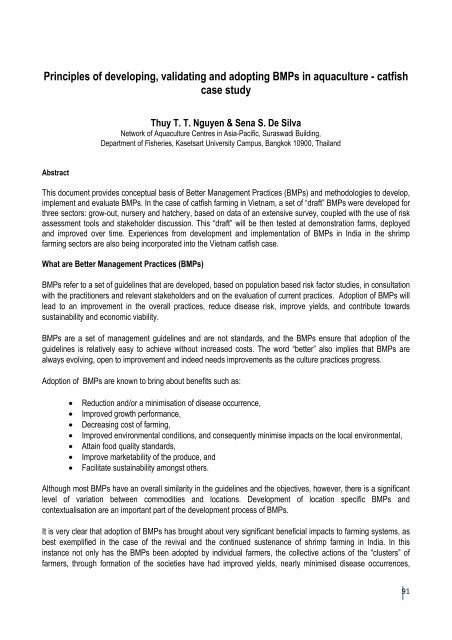Training of Trainers - Library - Network of Aquaculture Centres in ...
Training of Trainers - Library - Network of Aquaculture Centres in ...
Training of Trainers - Library - Network of Aquaculture Centres in ...
- No tags were found...
Create successful ePaper yourself
Turn your PDF publications into a flip-book with our unique Google optimized e-Paper software.
Pr<strong>in</strong>ciples <strong>of</strong> develop<strong>in</strong>g, validat<strong>in</strong>g and adopt<strong>in</strong>g BMPs <strong>in</strong> aquaculture - catfishcase studyThuy T. T. Nguyen & Sena S. De Silva<strong>Network</strong> <strong>of</strong> <strong>Aquaculture</strong> <strong>Centres</strong> <strong>in</strong> Asia-Pacific, Suraswadi Build<strong>in</strong>g,Department <strong>of</strong> Fisheries, Kasetsart University Campus, Bangkok 10900, ThailandAbstractThis document provides conceptual basis <strong>of</strong> Better Management Practices (BMPs) and methodologies to develop,implement and evaluate BMPs. In the case <strong>of</strong> catfish farm<strong>in</strong>g <strong>in</strong> Vietnam, a set <strong>of</strong> “draft” BMPs were developed forthree sectors: grow-out, nursery and hatchery, based on data <strong>of</strong> an extensive survey, coupled with the use <strong>of</strong> riskassessment tools and stakeholder discussion. This “draft” will be then tested at demonstration farms, deployedand improved over time. Experiences from development and implementation <strong>of</strong> BMPs <strong>in</strong> India <strong>in</strong> the shrimpfarm<strong>in</strong>g sectors are also be<strong>in</strong>g <strong>in</strong>corporated <strong>in</strong>to the Vietnam catfish case.What are Better Management Practices (BMPs)BMPs refer to a set <strong>of</strong> guidel<strong>in</strong>es that are developed, based on population based risk factor studies, <strong>in</strong> consultationwith the practitioners and relevant stakeholders and on the evaluation <strong>of</strong> current practices. Adoption <strong>of</strong> BMPs willlead to an improvement <strong>in</strong> the overall practices, reduce disease risk, improve yields, and contribute towardssusta<strong>in</strong>ability and economic viability.BMPs are a set <strong>of</strong> management guidel<strong>in</strong>es and are not standards, and the BMPs ensure that adoption <strong>of</strong> theguidel<strong>in</strong>es is relatively easy to achieve without <strong>in</strong>creased costs. The word “better” also implies that BMPs arealways evolv<strong>in</strong>g, open to improvement and <strong>in</strong>deed needs improvements as the culture practices progress.Adoption <strong>of</strong> BMPs are known to br<strong>in</strong>g about benefits such as:• Reduction and/or a m<strong>in</strong>imisation <strong>of</strong> disease occurrence,• Improved growth performance,• Decreas<strong>in</strong>g cost <strong>of</strong> farm<strong>in</strong>g,• Improved environmental conditions, and consequently m<strong>in</strong>imise impacts on the local environmental,• Atta<strong>in</strong> food quality standards,• Improve marketability <strong>of</strong> the produce, and• Facilitate susta<strong>in</strong>ability amongst others.Although most BMPs have an overall similarity <strong>in</strong> the guidel<strong>in</strong>es and the objectives, however, there is a significantlevel <strong>of</strong> variation between commodities and locations. Development <strong>of</strong> location specific BMPs andcontextualisation are an important part <strong>of</strong> the development process <strong>of</strong> BMPs.It is very clear that adoption <strong>of</strong> BMPs has brought about very significant beneficial impacts to farm<strong>in</strong>g systems, asbest exemplified <strong>in</strong> the case <strong>of</strong> the revival and the cont<strong>in</strong>ued sustenance <strong>of</strong> shrimp farm<strong>in</strong>g <strong>in</strong> India. In this<strong>in</strong>stance not only has the BMPs been adopted by <strong>in</strong>dividual farmers, the collective actions <strong>of</strong> the “clusters” <strong>of</strong>farmers, through formation <strong>of</strong> the societies have had improved yields, nearly m<strong>in</strong>imised disease occurrences,91
















